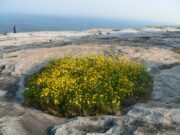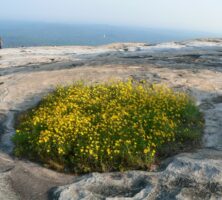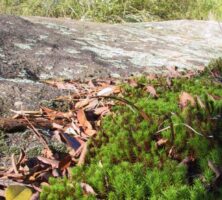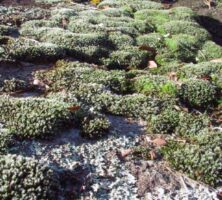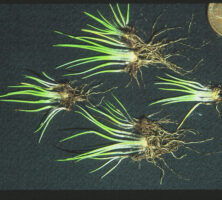Granite outcrops stand in stark contrast to the surrounding matrix of old-field areas and oak-hickory-pine forest. They are populated by a unique, highly specialized group of plant species that differ strikingly in aspect from adjacent areas that support zonal vegetation. Perhaps the most obvious differences are seen in the terrestrial plants that occur in areas associated with the bare granite.
One immediate difference that strikes an observer is the scarcity of woody plants. Whereas oaks, hickories, and pines dominate most of the Piedmont region, annual and perennial herbs with adaptations to avoid or resist drought reign supreme on granite outcrops. Among the few characteristic trees found on outcrops is Georgia oak (Quercus georgiana). Pines often grow on outcrops, too, with either loblolly pine (Pinus taeda) or shortleaf pine (P. echinata) eventually invading the deepest accumulations of soil over the rock. Another local name for granitic flatrocks is cedar rocks, reflecting the common occurrence of red cedar (Juniperus virginiana).
A few shrubs and woody vines, though by no means limited to granite outcrops, may grow especially well in the thin woods at the margins of outcrops. Fringe tree (Chionanthus virginicus), for example, seems to flower much more prolifically in such settings than in the dense shade of forests, as do wafer ash (Ptelea trifoliata), painted buckeye (Aesculus sylvatica), and serviceberry (Amelanchier arborea).Among the woody vines are such spectacular plants as yellow jessamine (Gelsemium sempervirens), crossvine (Bignonia capreolata), and greenbrier (Smilax smallii).
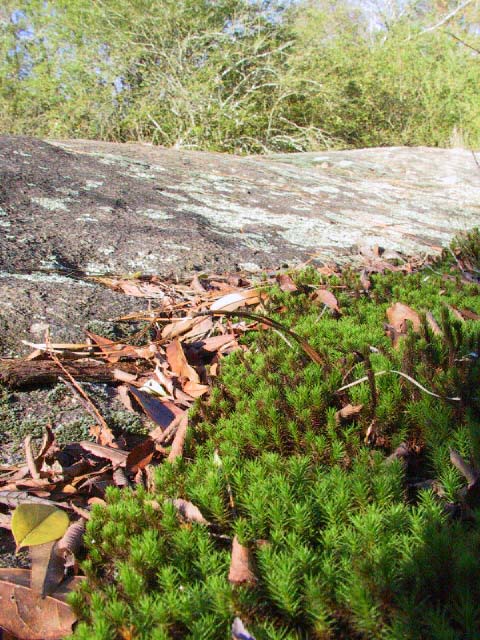
Photograph by Melinda Smith Mullikin, New Georgia Encyclopedia
It is the herbaceous plants, however, that give the granite outcrops their distinctive character. These plants are often classified into four categories, based on the maximum depth of soil over rock. The “diamorpha community,” existing in soil depths of one to three inches, consists of a single vascular plant, Diamorpha smallii. This diminutive winter annual is able to invade and dominate because of its ability to tolerate low moisture levels in the soil and because it is free from competition in this stressful microenvironment. Occasionally a few cryptogams (plants that reproduce through spores rather than seeds or flowers), including lichens and mosses, occur with D. smallii.
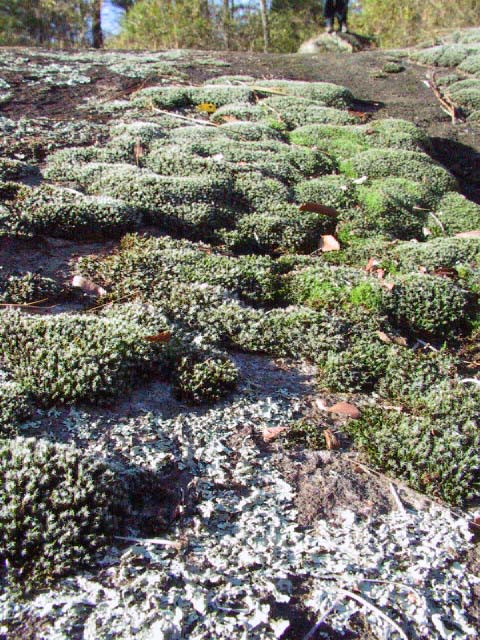
Photograph by Melinda Smith Mullikin, New Georgia Encyclopedia
Lichen–annual herb communities occupy depressions over granite where soil depths reach four to six inches. In the spring these areas are dominated by such annual plants as sandwort (Arenaria uniflora), toadflax (Nuttallanthus canadensis), and bentgrass (Agrostis elliottiana). In the fall these communities are dominated by the Confederate daisy (Viguiera porteri). More constant, but rarely dominating these areas, are lichens.
Annual-perennial herb communities occur on soils seven to sixteen inches deep. An important soil builder in these areas is the haircap moss (Polytrichum commune). On thinner soil the Confederate daisy and the succulent perennial rockpinks (Talinum mengesii or T. teretifolium) may dominate. Toward the center of the depression, on deeper soils, such perennial herbs as wooly ragwort or cottony groundsel (Senecio tomentosus), sunnybells (Schoenolirion croceum), crow poison (Nothoscordum bivalve), and broomsedge (Andropogon virginicus) hold sway. An interesting aspect of the vegetation development on these soil islands upon bare rock is the displacement of earlier colonizing species to the outer edges, where the soil is shallowest. This produces concentric rings of vegetation, with the perennials at the center and the diamorpha limited to the shallow soil on the periphery.
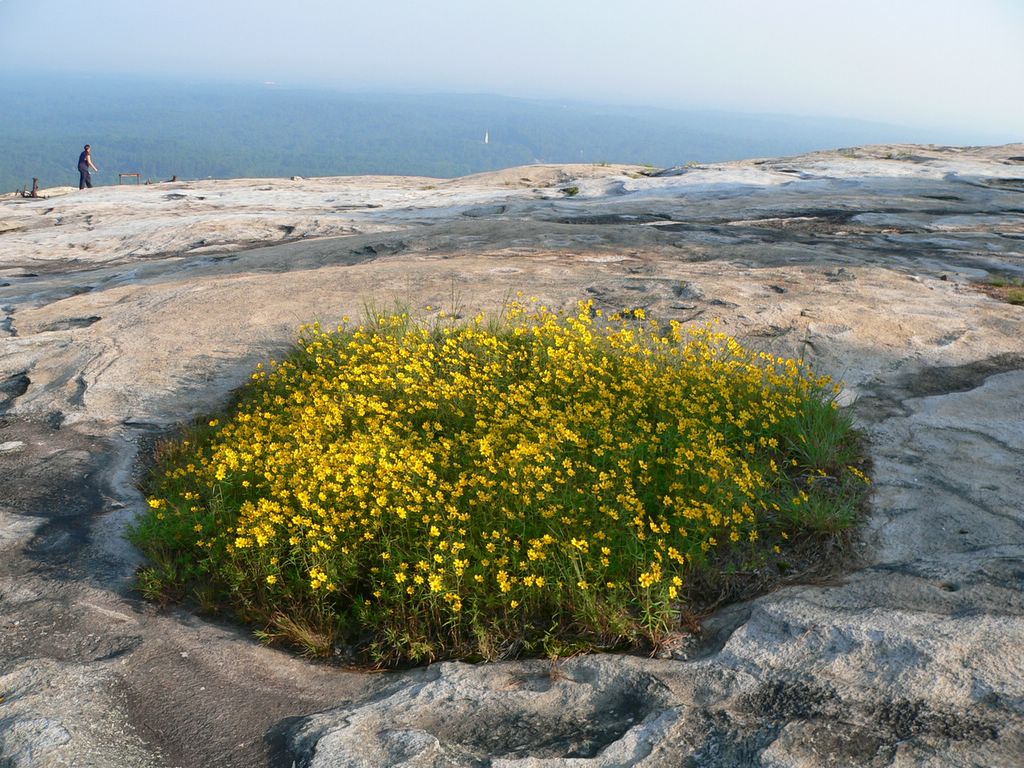
Photograph by Lee Coursey
The extremely hot, dry conditions in certain microenvironments on granite has led to a number of adaptations by the characteristic plants. Some perennial herbs—for example, prickly pear cactus (Opuntia humifusa) and rock pinks—tolerate drought by storing water in succulent stems or leaves. A number of annuals, including diamorpha, also have succulent tissues. Many plants on outcrops are significantly more hairy than their counterparts growing elsewhere. It seems likely that a dense covering of white hairs acts to increase the reflectivity of the plant’s leaves and thereby decrease the heat load. The hairs may also help to reduce evapotranspiration. The conspicuous livery-white hairpoints of the dominant moss on bare granite surfaces, Grimmia laevigata, may similarly work to increase albedo (the ability to reflect light) and reduce water loss.
Perhaps the most common solution to the stress posed by microenvironmental deserts on granite outcrops is drought avoidance. Poikilohydric mosses and lichens are natural resurrection plants that, following a drought, can photosynthesize soon after rehydration. The quillworts that occupy rock-rimmed pools, Isoetes melanospora and I. tegetiformans, are able to go dormant when the pools dry up in late spring, then resume growth whenever rainstorms refill the pools, regardless of season.
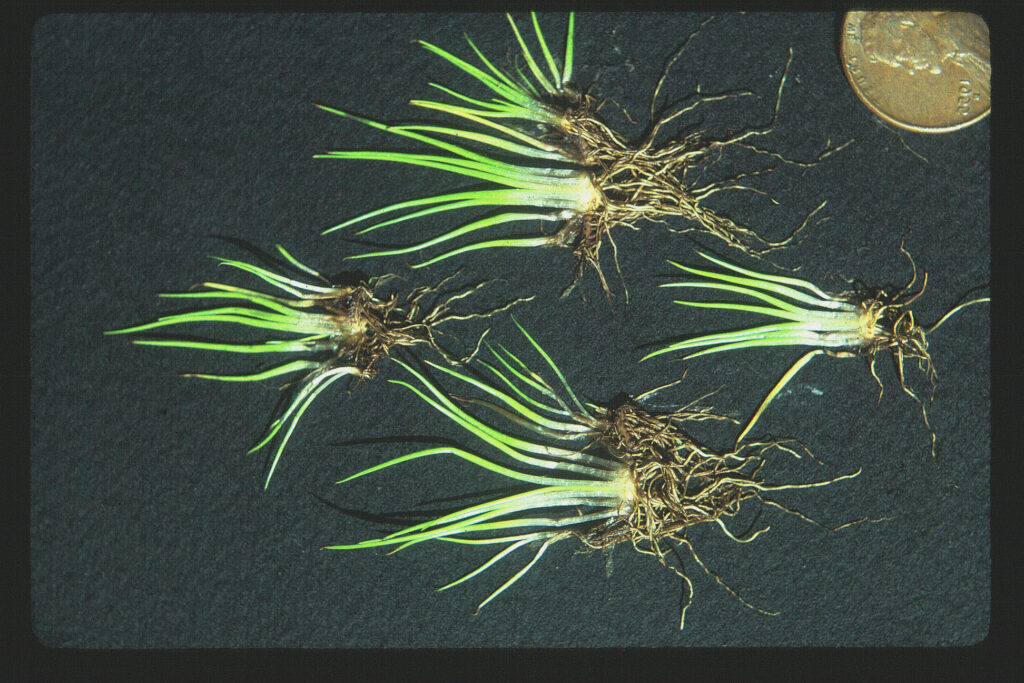
Courtesy of Georgia Department of Natural Resources.
Most of the endemic flowering plants on the outcrops have evolved to survive the extremes of summer and winter. Seeds germinate after late September or early October rains to produce rosettes of frost-resistant leaves. When temperatures begin to rise in late March or early April, the plants bolt and flower profusely. By early May, when the shallow soil depressions have become bone-dry, the winter annuals have already matured their crop of seeds, which typically require an after-ripening period of four to five months. Thus they are able to survive the extremely hot, dry summer months as dormant populations of drought-resistant seeds.


